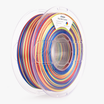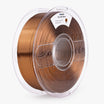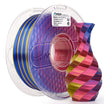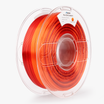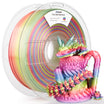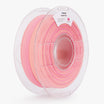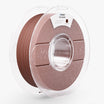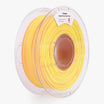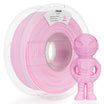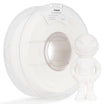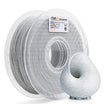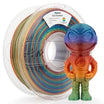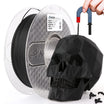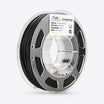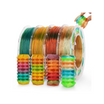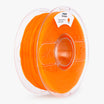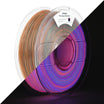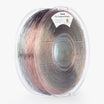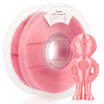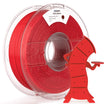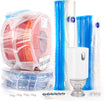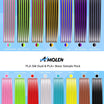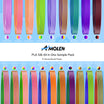Jumping into 3D printing is exciting but can be intimidating since there is so much technical information to digest. Something that is commonly neglected by new users is filament diameter. It might appear irrelevant next to finding the perfect printer or mastering slicing software, but filament diameter has a direct influence on how consistent prints are, how well materials play together, and the general printing process.
There are two standard sizes: 1.75mm and 2.85mm. Both have pros and cons. Knowing the difference can save you time, help you avoid printing issues, and ensure you have the appropriate filament for your printer and project requirements.
Why Filament Diameter Matters
Filament diameter determines how much material your extruder pushes through the hotend. When the filament and printer hardware are not compatible, you may encounter jams, under-extrusion, or prints that are fragile. Even when properly matched, the diameter of the filament influences:
- Precision and detail: finer diameters often allow smoother flow adjustments.
- Extrusion stability: thicker filaments resist bending in longer feed paths.
- Material variety: certain diameters are more widely available.
- Cost and accessibility: common sizes are easier and cheaper to source.
So while both 1.75mm and 2.85mm can produce excellent results, the "better" choice depends on your printer's design and the type of projects you plan to run.
Quick Choice for Filament Diameter
When deciding between 1.75mm and 2.85mm, the choice depends largely on your printer type and project needs. Use the quick pointers below to match your situation.
Beginners and Budget Printers
→ Choose 1.75mm
Most entry-level machines use 1.75mm; it's affordable, widely available, and offers the broadest material variety. Best option for beginners.
Owners of Printers Designed for 2.85mm
→ Stick with 2.85mm
Some models, especially Bowden-based printers, are built for 2.85mm. Switching to 1.75mm without a hardware swap risks jams.
Makers Working With Flexible Filaments
→ Go with 1.75mm + direct drive
Thinner filament feeds more reliably with soft materials like TPU, reducing buckling and improving print consistency.
Designers Printing Large Prototypes
→ Either size works
Print success depends on high-flow hotends and larger nozzles, not filament diameter. Both 1.75mm and 2.85mm can handle big models with proper tuning.
More Details You Should Know About 1.75mm and 2.85mm Filament
The two diameters vary in market share and history. 1.75mm has become the worldwide standard among hobbyist and prosumer printers, whereas 2.85mm is the contemporary descendant of the original "3.0mm" filament that some industrial and Bowden-based printers still use.
Overview of Common Filament Diameters
| Factor | 1.75mm | 2.85mm |
| Market presence | Dominant in consumer printers | Less common, tied to certain brands |
| Material options | Wide: PLA, ABS, PETG, TPU, nylon, composites | Fewer options, but supply is improving |
| Extrusion control | Smooth flow control, ideal for fine details | Steadier feed in long Bowden tubes |
| Flexible filaments | Performs well with direct drive extruders | More prone to buckling in Bowden setups |
| Print speed / large models | Relies on hotend flow rate & nozzle size, not diameter itself | Same as 1.75mm – diameter alone isn't decisive |
| Availability & price | Affordable, easy to find everywhere | More limited stock, slightly higher price |
| Typical users | Beginners, hobbyists, multi-material experimenters | Users with machines natively designed for 2.85mm |
1.75mm Filament in Detail
Advantages:
- Universal compatibility: Almost every entry-level and mid-range 3D printer supports 1.75mm filament, making it the safest choice for new users.
- Precision for small features: The thinner diameter allows more granular extrusion control, which benefits prints with sharp corners, fine text, or miniature models.
- Broadest material range: From budget PLA to flexible TPU and advanced composites, 1.75mm is available in virtually every material.
- Lower cost and easier sourcing: Its popularity drives competition, which means lower prices and more suppliers worldwide.
Disadvantages:
- Prone to bending in Bowden tubes: Because the filament is thinner, it can flex or buckle in very long feed paths, especially with soft materials.
- Greater sensitivity to poor hardware: In printers with weak extruders or poorly designed hotends, 1.75mm may show under-extrusion or jams if not well tuned.
2.85mm Filament in Detail
Advantages:
- Stable feeding in Bowden systems: The thicker filament is more rigid, which helps prevent buckling in printers with long PTFE tubes.
- Robust extrusion: With a larger cross-section, each millimeter of filament delivers more plastic. This can be an advantage when working with high-flow nozzles, as the extruder pushes material more steadily.
- Industrial roots: Many professional-grade printers, especially those designed a decade ago, were built around 3.0mm (now effectively 2.85mm). Users of these machines still benefit from their stability.
Disadvantages:
- Limited printer compatibility: Few consumer printers support it today. Unless your machine specifies 2.85mm, it cannot be used without a full hardware swap.
- Smaller material selection: While manufacturers are expanding their lines, the catalog is still much smaller than 1.75mm.
- Price and availability: Often more expensive and harder to find, especially outside major suppliers.
How to Step by Step Choose the Best Filament Diameter
When deciding between the two, consider these factors:
1. Printer Compatibility
- Check your printer's manual. If it says 1.75mm, that's what you must use.
- If it says 2.85mm or 3.0mm, stick with 2.85mm. Most "3.0mm" filament sold today actually measures about 2.85mm.
2. Print Detail vs. Print Size
- For miniatures, detailed prototypes, or intricate parts, 1.75mm offers finer flow adjustments.
- For large objects, the decisive factors are nozzle diameter (e.g., 0.6–1.0mm) and hotend throughput—not filament size.
3. Material Experimentation
- If you want to try many types of filament, 1.75mm gives you the broadest range.
- If your machine is natively 2.85mm, stay with that unless you plan to retrofit the entire extrusion system.
4. Budget and Availability
- 1.75mm is generally cheaper and stocked everywhere.
- 2.85mm may require planning ahead and ordering from specialty suppliers.
Common Beginner Misconceptions
| Misconception | Reality |
| ABS requires 2.85mm | False. Both 1.75mm and 2.85mm can print ABS. Success depends on hotend temperature, bed adhesion, and enclosure stability, not filament diameter. |
| 2.85mm clogs less often | Not necessarily. Clogs are usually caused by heat creep, poor cooling, or dirty filament, not the diameter itself. |
| 3.0mm and 2.85mm are different | In practice, they are the same category. Spools labeled 3.0mm typically measure around 2.85mm, and slicers should be set to 2.85mm. |
| Thicker filament is always better for large prints | Not by itself. Large prints require high-flow hotends and bigger nozzles; filament diameter alone |
Regardless of which filament diameter you choose, nozzle clogging remains one of the most frustrating issues in 3D printing. Understanding the root causes of clogs and knowing how to prevent them will significantly improve your printing experience with either size.
Start Printing With the Diameter That Fits Your Printer
Both 1.75mm and 2.85mm filaments can yield great results when used with the right equipment. The secret lies in making sure they are compatible with the extrusion system of your printer. Other than that, your print quality relies much more on the hotend capacity, nozzle size, slicer tuning, and filament storage than merely the filament diameter.
If you're a beginner or doing this for fun, ideally the most suitable diameter is 1.75mm filaments as it's cheap, flexible, and easily available. But you don't have to change if your machine supports 2.85mm. Really, the best filament diameter is what your machine was designed for.

